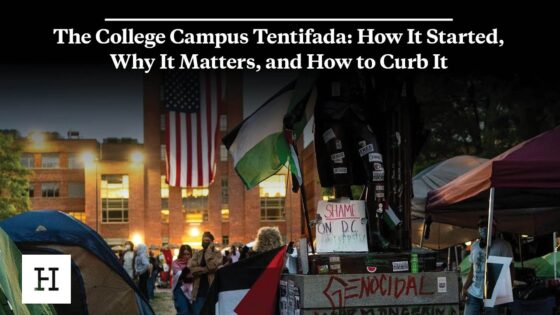The very title of the Nadia Abu El-Haj’s Facts on the Ground invites controversy. The phrase “facts on the ground” originally referred to a cardinal principle of the post-1967 Israeli settler movement, which held that by building and occupying settlements in the newly-controlled West Bank it would be able to create an undeniable dominion over Palestinian lands that would be impossible to dislodge. As used in El-Haj’s book, the phrase refers to the entire archeological enterprise in this region of the world, which beginning in the 19th century, she charges, invented a mythological story of Israelite and Jewish historical presence in the land of Israel, and imbued that story with the false aura of factuality that has also proven impossible to dislodge. In her view, archeology is a “colonial science” whose main goal has been to intellectually erase the history of Palestinians from the land.
Since its publication, the book has engendered controversy that continues to resound throughout academia and the media. Some responses have been quite predictable. It would be hard to imagine that passions would not be raised by such a broad scale attack on two centuries of archeology in this region. But the book has also been the subject of serious and sober scholarly reviews, both in Israel and abroad-some harshly critical, others more laudatory. One of its harshest critics, the Israeli archeologist Aren Maeir, regards the book as having virtually no scientific merit, and describes it as simply a “political manifesto.” Even more sympathetic archeological reviewers, such as Tim Murray of La Trobe University in Australia, describe the analysis of archeological theory and socio-politics of the discipline itself as “limited” and “idiosyncratic.” These reviews suggest that the book demonstrates a poor grasp of archeological theory and practice. In stark contrast, numerous non-archeologist anthropologists have described it as “sophisticated,” “meticulous” and “important.” The cleavage between the archeologists and non-archeologists is profound. How can a work that apparently demonstrates an impaired understanding of the archeological sciences be regarded as good anthropology?
Part of the explanation can be found in the political climate in which cultural anthropological knowledge (as distinguished from archeology) is created. Although ethnographers continue to produce important and scholarly work, many areas of anthropology are guided primarily by political considerations. Hostility to the state of Israel and the Jewish nationalism is the norm in many sectors of anthropology. In this intellectual climate, it is routine to regard Israel as a colonial or neocolonial state, an agent of imperialism, and an oppressor of the Palestinian people. One hardly needs to be Braveheart to be openly antagonistic to Israel at a meeting of anthropologists.
But politicization also derives from the impact of literary criticism and cultural studies upon anthropological method. Facts on the Ground is profoundly shaped by Edward Said’s book Orientalism, which clearly rejects the idea of the objectivity of knowledge. Said’s view is that science itself developed in the context of colonialism. By locating the scientific enterprise within the colonial, it becomes possible for writers like El-Haj to create labels such as “colonial science” that treat archeology in much the way old line-Marxists used the idea of “bourgeois science” to try to expunge Mendelian genetics from Soviet scientific thought. Like genetics, archeology is treated as suspect because it allegedly serves the interests of ruling groups.
But the problems with this approach actually run much deeper. In Orientalism, Said argued that the traditional scholarly study of the Middle East constituted a racist and imperialist discourse. As borrowed from Foucault, the concept of discourse refers to a set of interconnected ideas. One of the most distinctive conceptual elements of “discourse” is that it is not rule-bound; its connective threads are neither empirical nor logical but political and often comprise a disparate collection of ideas strung together in a come-what-may manner. Small wonder that Jacques Derrida, one of the framers of the concept of discourse, was immediately attracted to Claude Levi-Strauss’ concept of bricolage. In his classical study of mythology, Levi-Strauss argued that all myths are essentially a bricolage; their stories, characters, and conceptual elements constructed willy-nilly out of what was at hand. Derrida married the study of myth to the study of discourse by arguing that all modes of thought could be understood as bricolage. But almost in imitation of its subject, post-colonial studies, cultural studies, and their anthropological progeny have now adopted bricolage as their primary methodology. Borrowing thoughts and ideas indiscriminately from the worlds of literary criticism, literature, law, politics and in this instance from archeology, they construct their analyses with little concern for empirical or logical connectedness. Like mythology, they are masters of the found object, and pull in anything to create a story. This methodology has no connection to science. Its power lies in its politics and its aesthetics, and not in such boring ideas as validity and reliability.
It is within this framework that Facts on the Ground is situated. Post-colonial discourse has intellectually colonized much of the anthropology of the Middle East. As a form of bricolage unburdened by rules of evidence or proof, it pulls together snippets of anything and everything to weave its dismal tale of unfettered nationalism and colonialism. The task is made easier by the book’s definition of archeology, which intentionally conflates professional and scientific practices with popular and political uses of archeological material. Imagine the results if this definition were applied to cultural anthropology in the United States. Every use of anthropology, from the crackpot to the sublime, could be attributed back to the profession. And so it goes: a potsherd here and a potsherd there, a bizarre comment by a tour guide, a film in a museum exhibition all become grist for the mill.
The book is rife with instances of this mode of analysis. For example, Facts on the Ground takes issue with the archeological exhibition at Burnt House, a museum located in the Jewish Quarter of Jerusalem’s Old City. The official interpretation is that Burnt House is the home of a wealthy Jewish family, possibly of the priestly class, that was destroyed during the Roman siege and conquest of Jerusalem in 70 AD. El-Haj participated in a tour of this Museum and other related sites along with an “American writer” and a “British archeologist,” both of whom are unnamed. El-Haj recounts that during the tour, the unnamed and uncited American writer whom she describes as “having authored several books and articles on the politics of archeology in Israel” objected to the established narrative of Burnt House. He argued that the destruction of the house might have resulted from class conflict among Jews in Jerusalem, the result of the simmering anger against Jerusalem’s nobility by working class laborers whom Herod the Great had imported to build the temple. He postulated that Burnt House might have been burnt down by an angry Jewish mob long prior to 70 CE. The curator countered that a coin found at the site and dated to approximately 66 CE suggests that the house was burnt close to the 70 CE time period. (The building of Herod’s Temple began in about 19 BCE. Herod died in 4 BCE, but the building project may have continued well past his death.) El-Haj counters that this evidence does not preclude the possibility that the site, including the House, may have been burnt down more than once. The unnamed “British archeologist” apparently adds another view by asserting that “most cities burn every twenty to twenty five years.”
The point here is that El-Haj suggests there are possible interpretations other than the established narrative. If the Museum were to present either the class struggle narrative or the natural cycle of fire narrative as alternative possibilities, it would, in her view, be a strong corrective to the narrative of national loss and ascendance that she believes wrongfully pervades Israeli archeology. But the text offers no evidence that either of these alternate narratives is probable or even plausible. What weight would any scientific study accord to this exchange other than it demonstrates a passion for contested narratives? It certainly offers nothing probative of the existence of any facts different from those now presented at Burnt House. Certainly it would be interesting and important if El-Haj were actually able to demonstrate that the ethos of Israeli nationalism screened out important and contradictory data. But she offers nothing stronger than anecdote to make the case. Given its methodology, Facts on the Ground accords carefully constructed archeological evidence and off-the-cuff anecdote exactly the same weight.
Facts on the Ground is a book that turns the gaze of post-colonial discourse to the subject of archeology. Inspired by mythology, it tells a powerful story that never lets facts get in the way.




